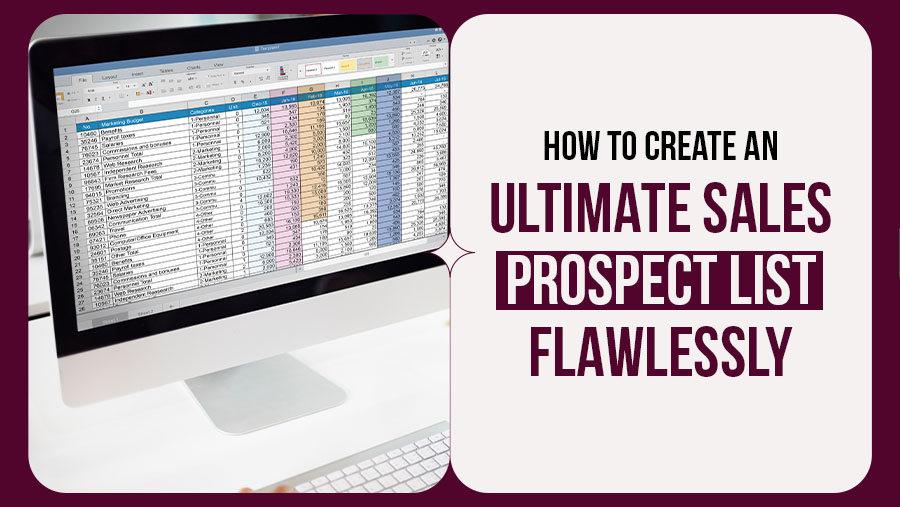
How To Create An Ultimate Sales Prospect List Flawlessly
Let’s Begin
Hey there! Are you looking for ways to increase your sales and grow your business? One of the most important things you can do is to create a strong sales prospect list.
So, where do you start? This article will cover the key steps to identifying your target market, gathering contact information, organizing and segmenting your list, and using your prospecting list to drive sales.
We'll also share some tips and tricks on how to use your list effectively and make the most out of it. So, whether you're a sales development pro or just starting out, this article will give you the tools you need to create a killer sales prospect list and take your revenues to the next level.
So, have a cup of coffee, grab a pen and a notebook, and let's get started!
The necessary steps you need to take for a fantastic prospecting list are:
- Understand your Target ICP
- Finding your prospects
- Organizing and Segmenting Your List
- Using Your List

Understanding Your Target ICP
Okay, so the first step in creating a killer sales prospect list is identifying your target ideal customer profile (ICP). This is essential to figure out who is your ideal customer and what are their needs and pain points.
It's important to be specific here, as the more you know about your target market, the better you can tailor your prospecting list to them.
For example, instead of just targeting "all businesses", you could target "small and medium-sized businesses in the healthcare industry."
By narrowing down your focus like this, you'll be able to create a more effective sales strategy. It is said that 9 in 10 buying decisions are made with peer recommendations, meaning that your target market communicates with each other.
You can also use tools such as surveys, focus groups, and customer interviews to better understand your target market's needs and pain points. This will help you create a more effective sales message, increase your chances of closing a sale, and make a better sales prospecting list.
Finding prospects
Great! Now that you have a clear idea of your target market, it's time to start gathering contact information for your sales prospect list.
There are several ways to do this, including using social media and professional networking sites like LinkedIn, buying or renting a list, scraping data from the web, or utilizing internal resources such as your current prospecting list.
The key is to make sure you are collecting accurate and up-to-date information. You can also use tools such as LinkedIn Sales Navigator to search and filter the right prospects and export the contact information.
Remember, the more information you have on a prospect, the better equipped you'll be to personalize your sales outreach and prospecting list and increase your chances of closing a sale.
Also, make sure to verify the contact information before you add it to your list. This will help you avoid reaching out to the wrong person or an outdated email address. Use free email verification tools like Hunter, Neverbounce, and EmailHippo.
Organizing and Segmenting your list
Alright, you've got a ton of contact information now and it's time to get organized!
One of the most important things you can do is to segment your sales prospecting list by different criteria, such as industry, company size, job title, revenue, and other relevant factors. This will help you create targeted marketing campaigns and personalize your sales outreach.
For example, if you sell enterprise software, segment your prospecting list into different industries, such as finance, healthcare, or retail.
Additionally, you can prioritize your leads based on their likelihood of becoming customers, such as those who have shown interest or have similar characteristics to your current customers. This will allow you to focus your efforts on the most promising leads.
And remember to keep track of lead interactions and progress. It will help you know where your leads are in the sales process. In addition, by organizing and segmenting your B2B sales prospect list, you'll be able to effectively target the right prospects and improve your chances of closing a sale.
And remember to update and maintain your list regularly. It will help you keep track of the progress of your list of leads and know when to reach out to them.
Warm up your list
Alright, now that you've got a well-organized and segmented prospecting list, it's time to put it to use! One of the most effective ways to use your list is by creating targeted marketing campaigns.
For example, you could send a targeted email campaign to a segment of your sales prospecting list of small healthcare businesses. This will allow you to address the pain points and needs of that specific group of prospects.
Another way to use your prospect list is by personalizing your sales outreach. For example, instead of sending generic emails or making generic phone calls, you can use the information you have on a prospect to tailor your message and make it more relevant to them.
For example, if you know a prospect is a small business owner, you could mention how your product can help them increase sales and streamline their operations.
Finally, you can use your list to measure the effectiveness of your efforts by tracking open rates, click-through rates, and conversion rates. This will help you optimize your campaigns and make data-driven decisions on how to improve your sales process.
By using your list effectively, you'll be able to increase your sales and grow your business.
Channels for Sales Prospecting
1. Cold Calling
Cold calling is a tried-and-true sales prospecting method when you phone a potential customer to check if they're interested in your good or service.
However, the majority of customers today consider cold calling to be an intrusive and bothersome sales technique.
Receiving calls from an unknown salesperson won't likely make your potential customer happy, which can sabotage your entire sales prospecting process and your prospecting list.
2. Email Marketing
Email Marketing offers a less invasive technique to find B2B customers for your sales prospecting list than cold calling.
Sending customized emails catered to your prospect's particular demands is part of this prospecting strategy. In your email message, you try to persuade your ideal prospect why you're the best option for their needs.
3. Content Marketing
With content marketing, you want to draw inbound leads and turn them into paying clients for your prospecting list.
You develop value-added content assets that are accustomed to your ideal clients, such as blog articles, case studies, whitepapers, and infographics. By doing this, you can position yourself as someone they can rely on.
4. Sales Prospecting Tools
Sales prospecting tools play a crucial role in creating sales prospect lists. They use automation to quickly find, organize, and enrich potential leads, ensuring that each contact is verified and relevant for outreach.
AI-based prospecting tools, like Clearout, are also available as Chrome extensions. They provide information such as a prospect’s verified email address, phone number, industry preferences, and more. Armed with this information, sales teams can craft tailored strategies for each lead, leading to a more efficient and targeted approach in building and utilizing a sales prospect list.
5. Social Selling
Social networking sites like LinkedIn, Facebook, Instagram, and Twitter can help you find and connect with suitable leads and further build your sales prospecting list.
Keep in mind that this prospecting technique only succeeds if you approach potential clients through the channels they favor.
6. Conversational Marketing
Chatbots are used in conversational marketing to engage website visitors based on pre-established situations or by applying artificial intelligence.
They aid you in: Describing your goods or services, assembling lead data, preparing leads, and much more.
In essence, chatbots let you save time by automating some steps in your sales prospecting list.
7. Referrals
A great way to build your prospecting sales list is by using referrals.
Here, one of your current clients recommends you to a new customer. Their suggestions are credible, seem genuine, and have the power to persuade a qualified prospect to become a paying customer.
However, for referrals to be successful, you must continually uphold your obligations to current clients and offer a top-notch customer experience.
8. Networking events
You can discover new sales chances by going to events like trade shows and conferences. The additional benefit of events is that they allow you to monitor what your rivals are doing.
However, you'll need good sales training and a sound game plan to apply prospecting techniques during events.
To Sum It Up
And there you have it, a comprehensive guide on creating a sales prospect list that will help you increase your sales and grow your business.
Remember, the key is identifying your target market, gathering accurate and up-to-date contact information, organizing and segmenting your list, and using it effectively to drive sales.
One company that can help you with this process is Revnew, a powerful lead generation company that allows you to find and reach your ideal customers. It allows you to search and filter the right prospects, export the contact information, and track your interactions with them. Revnew also emphasizes segmentation and prioritization, allowing you to focus your efforts on the most promising leads.
In conclusion, a well-built and targeted sales prospect list is essential for increasing sales and growing your business. By following the steps outlined in this article and using companies like Revnew, you'll be well on your way to creating a sales prospect list that will help you reach your sales goals. So, go out there and start building your ultimate sales prospect list today!




